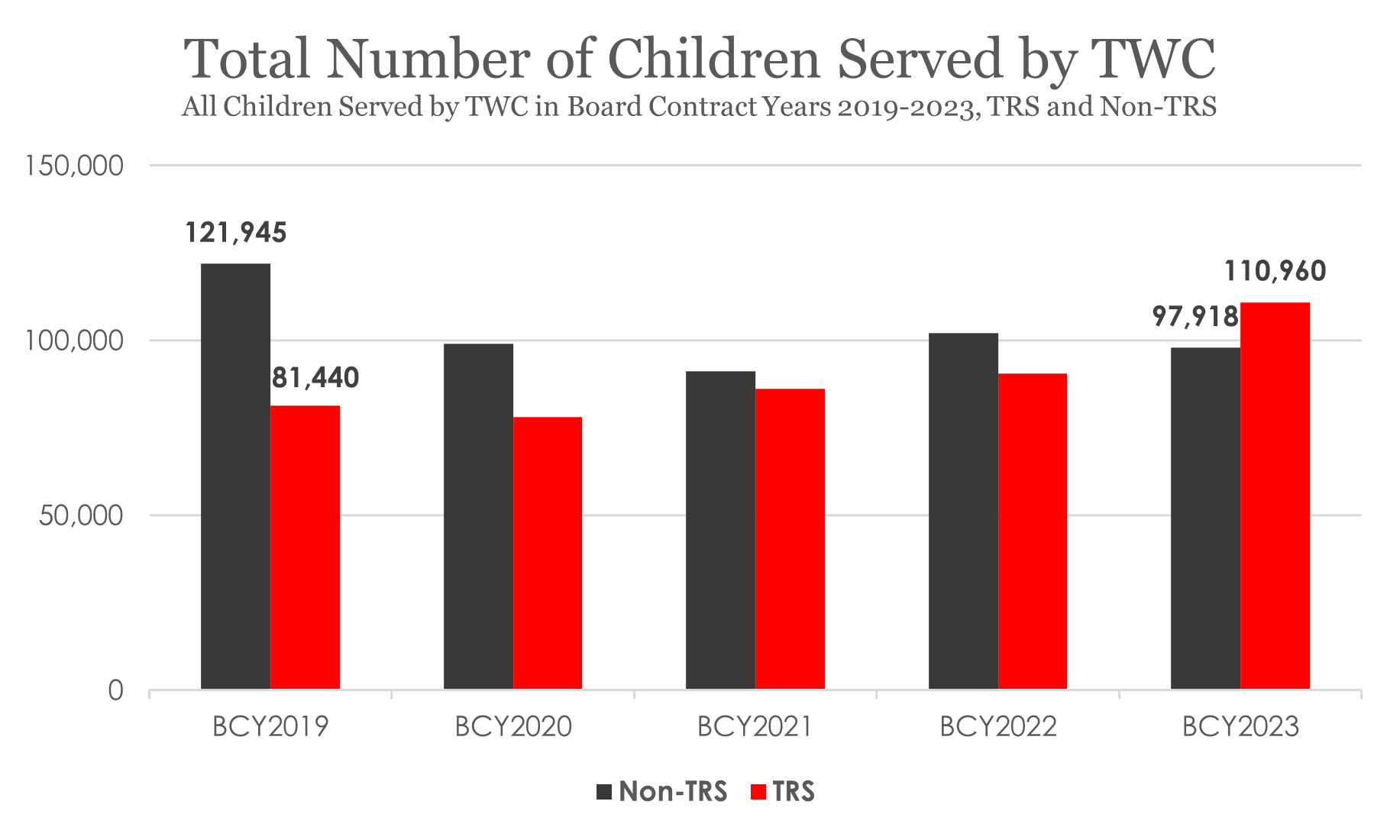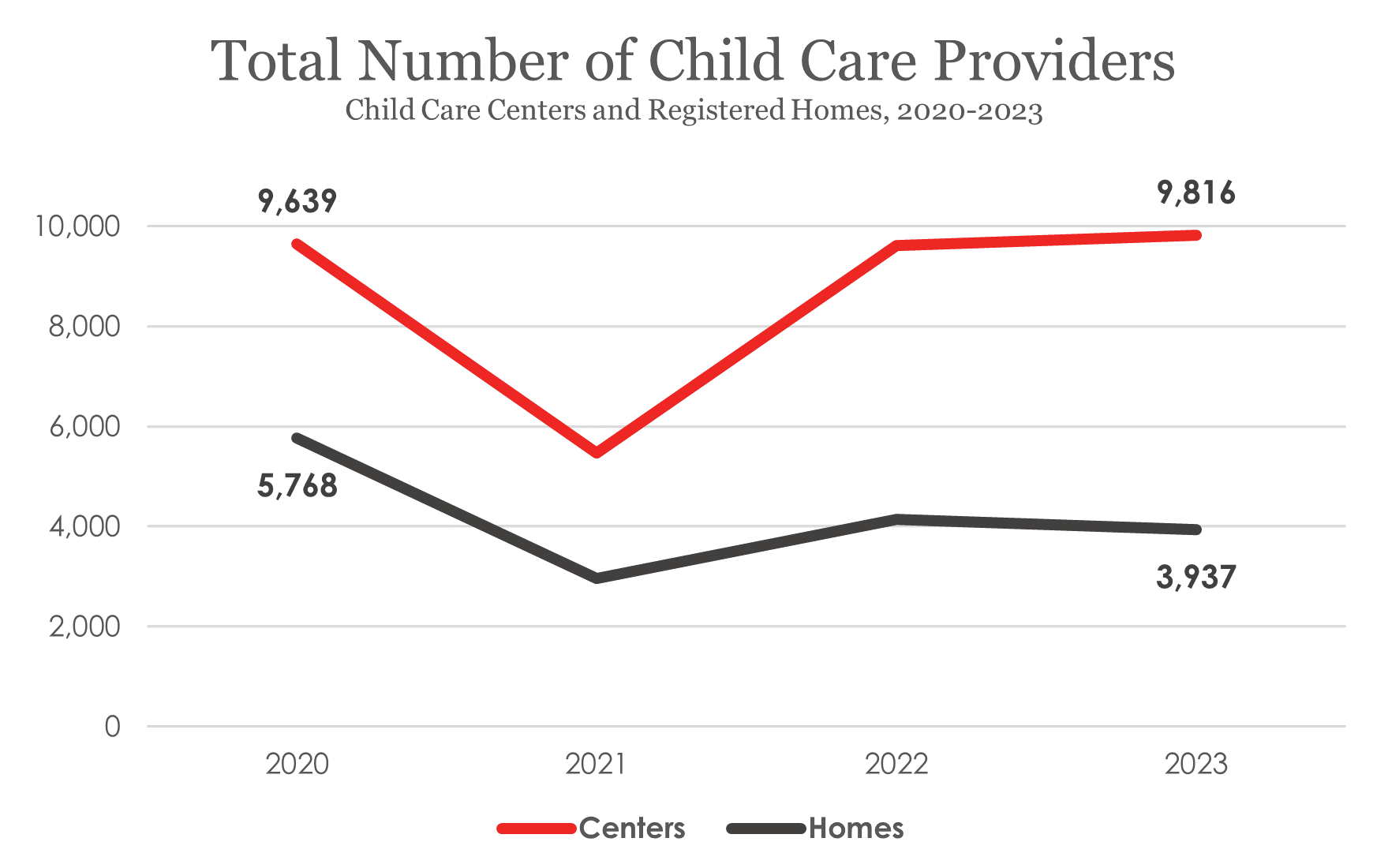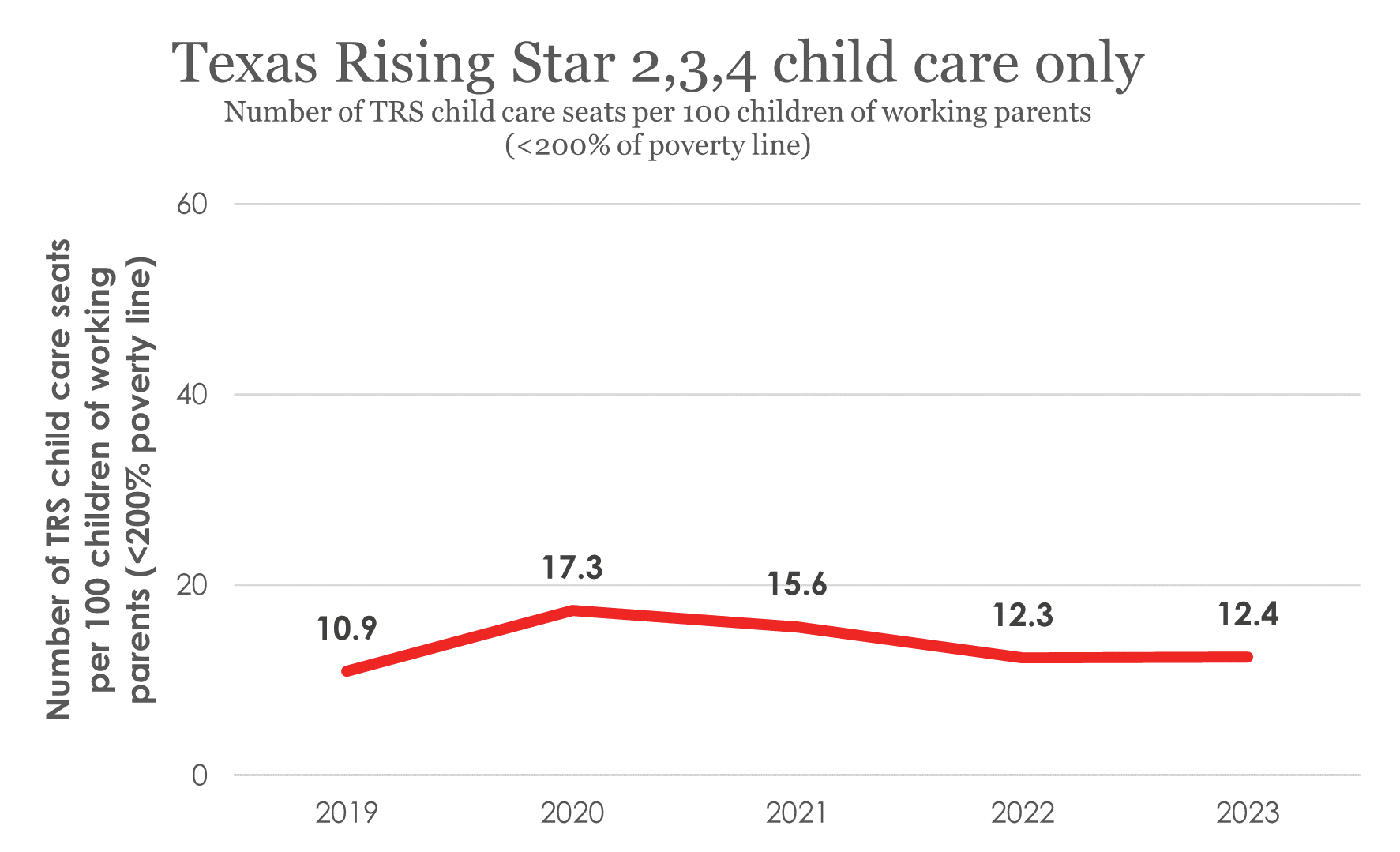By Kim Kofron, Early Childhood Education, and Jenn Meier, Center for Social Measurement and Evaluation
(Note: Data sources are all publicly available from the Texas Workforce Commission, TEA, and Family Service. This report uses data from October 1st, 2022-September 30th 2023)
Texas Child Care Landscape
Across Texas, over 60% of all child care providers – nearly 8,000 licensed child care centers and homes receive child care subsidy, or scholarships, through Texas Workforce Commission (TWC). However, many parents who qualify for subsidy care have limited options of high quality child care providers (those rated by the state’s Quality Rating and Improvement System, known as the Texas Rising Star). As of September 2023, there are nearly 95,000 children on the waitlist.
In many places across Texas there simply are too few child care providers – and child care seats – in the subsidy system to meet the demand. The number of children ages 0-5 with working parents in Texas decreased slightly in 2023 compared to the previous year. However, the number of children with working parents who are below 200% of the federal poverty line (low-income) increased in 2023 from 462,407 to 475,644. Over 4 in 10 children with working parents (45%) are low-income and are eligible for subsidized child care.

Child care homes and centers saw the overall number of children enrolled in child care increase in Texas Workforce Commission Board Contract Year (BCY) 2023, with a portion of the growth coming from increased enrollment in Texas Rising Star-certified programs. Texas Workforce Commission’s daily capacity for subsidized child care is around 138,000, meaning an estimated 337,000 low-income eligible children ages 0-5 were not served by TWC. On average, a combined 18,665 infants and toddlers were served each day by TRS child care providers in BCY 2023, representing almost one-third (29.5%) of the number of children served through TRS.
In BCY 2023, only 2,618 child care providers participated in TRS (34.2%), reflecting a 34.3% increase in the number of providers participating in TRS from the previous year. As of December 2023, nearly two-thirds (60.6%) of all regulated providers in the Texas Statewide System accepted subsidies. After losing 21% of child care providers between March 2020 and September 2021, child care centers have rebounded from the effects of the COVID-19 pandemic more quickly than child care homes. The number of child care centers in operation has increased by 1.8% since 2020, whereas the number of child care homes has fallen by 31.7% over the same period.

The next section of the report discusses child care deserts in Texas, particularly as they relate to children ages 0-5 of working parents who are low-income.
Child Care Deserts in Texas
Every year, CHILDREN AT RISK analyzes data to assess the supply and demand for child care from every zip code across the state and identify areas of Texas lacking adequate child care options for the number of children residing in those communities. A zip code is deemed a “child care desert” if the number of children under age 6 with working parents is three times greater than the licensed capacity of child care providers in the area.
You can explore our Texas child care desert map here.
83.2% of children from low-income families, around 396,000 low-income children under age 6 with working parents, live in a zip code where the supply of subsidized child care meets less than a third of the demand. Similarly, more than 9 in 10 low-income children ages 0-5, or 94.3%, live in a Texas Rising Star desert. This means even though only 1 in 10 Texas children ages 0-5 with working parents live in a child care desert overall, low-income families have a much more challenging time not only finding child care, but finding quality child care.
In Texas, there are an estimated 337,000 more low-income children ages 0-5 with working parents than available subsidized child care seats. Of the roughly 138,000 subsidized child care seats available, close to 50,000 are allotted to school age children. This means approximately 1 in 5, or 19.6%, low-income children ages 0-5 with working parents not participating in head start/early head start or public pre-k programs are served through the Texas Workforce Commission.

The data demonstrate the lack of access to quality early child care is nearly universal throughout Texas among low-income families.
Summary and Call to Action
The Texas Legislature passed HB 2607 in 2021 which mandates participation in TRS for child care providers receiving subsidy reimbursement. This has resulted in:
- A decrease in zip codes defined as TRS child care deserts (1,016 to 796)
- A 34.3% increase in provider participation in TRS between 2022 and 2023
Despite these gains, there has been little change in the actual number of TRS child care seats per 100 low-income children of working parents, highlighting the continued need for high-quality subsidized child care in the state.

With almost half of our child population living with working parents who are below 200% of the federal poverty line, we must continue to advocate for access to quality child care programs that parents can afford while working. Through September 2023, child care programs had the additional financial support of the Child Care Relief Funds made available through the federal COVID-19 relief dollars, which proved vital in keeping child care programs open. With the knowledge those dollars were ending and the child care industry still unstable, the 88th Legislature passed SB 1145 to provide property tax relief to eligible child care programs, providing some financial relief beginning in 2024.
However, more needs to be done to provide families access to high quality child care which has historically been under funded in Texas. As advocates and policymakers prepare for the 89th Legislative Session, decisionmakers should consider the following actions to improve the state of child care in Texas:
- Secure revenue to reduce child care deserts and waiting lists for Texas’ working families by aligning the capacity of providers (supply) to the communities who truly need it (demand).
- Address reimbursement rates for child care providers, allowing them to serve more children in low-income working families.
- Increase support for home-based providers to reduce child care deserts.